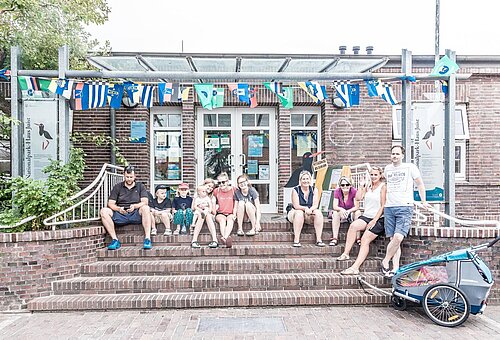
Nationalpark-Haus Juist
Learn all there is to know about the Nationalpark-Haus Juist! → ✓ Wide offers ✓ Exhibition ✓ Guided tours ✓ Mud flat hikes ✓ Family-friendly events
Learn more
Wow!
Right in the middle instead of just being there!
The car-free North Sea island of Juist is located in the middle of the fascinating World Heritage Site and Lower Saxony Wadden Sea National Park.
The Juist National Park fascinates!
Did you know that ...
... live on one m² of ground in the Wadden Sea?
Crazy, isn't it?
Big word, even bigger meaning for flora and fauna
Since 2009, the Wadden Sea is a UNESCO World Heritage Site and belongs to the same category as the Great Barrier Reef: a place that must be protected at all costs. About 500 km long, the Wadden Sea stretches from the Netherlands to the Danish border and Juist is pretty much in the middle of it! And even more: The area is about 10.000 km²: You have to imagine that first. To help you: The Wadden Sea is more than 1 million soccer fields big. Huge!
The Wadden Sea is not only magically beautiful, but also offers a unique habitat for animals and plants. "Specialized" animal species have found their permanent or temporary home here - such as the migratory birds that rest here before their journey to warmer places.
Although the Wadden Sea accounts for only about 0.03% of Germany's total land area, about a quarter of the country's plants and about a fifth of its animals are found here.
In 2016, a whole 295 plant species were counted on Juist - also 71 bird species and 54 butterfly species. Amazing!
The no longer so secret stars of the Wadden Sea
Adaptable and true survival artists: these five little animals are representative of the Wadden Sea habitat. Do you know them all?
And yet - even though the Wadden Sea has so many incredibly beautiful sights, species worthy of protection and enchanting plants to offer, this Wadden Sea habitat is threatened. Climate change, overfishing, tourism and many other crises are causing problems for the Wadden Sea. The island municipality of Juist as an official partner of the Lower Saxony Wadden Sea National Park tries everything to inform and sensitize its guests - and that's where you come on board!
You can get confused, absolutely! Juist is a particularly beautiful spot on earth and this is also shown by the official descriptions of the Wadden Sea. Sometimes we say "Wadden Sea World Heritage" and sometimes "Wadden Sea National Park"... But which is true?
Well, we asked the experts, our National Park Ranger Markus Großewinkelmann and the director of the National Park House on Juist, Jens Heyken. We are happy to share the following information with you (a little bit of bragging knowledge for those at home):
Love your dream island
Juist is located in the middle of the Wadden Sea. With such a location comes understanding for nature. We Juister and Juisterinnen protect our home as best we can and we ask you to help us, too. To preserve the Wadden Sea - that is our great concern, so that your children can also enjoy this breathtaking landscape for a long time to come.
Many paths and guided tours allow you to experience the Wadden Sea and to enjoy this natural spectacle respectfully: Please do not leave the marked paths and do not go into the Wadden Sea alone. Take part in a guided tour and let yourself be introduced to the secrets of the Wadden Sea. Walk along the paths on the island and learn from the display boards.
Experience and respect nature
On Juist you will find many signs with marked protection zones. Please respect them accordingly and follow the rules. Only in this way can man, animal and nature coexist.
The following protected zones await you on Juist:
You can get further information on the leaflets in the tourist information offices or in the National Park House.
Change language
Datenschutzeinstellungen
In order to provide the best user experience, we require some tools and technologies provided by third parties. Here you can see a list of external tools and decide whether to allow them or not. If you want to change your preferences afterwards, you can do so on our privacy agreement page. Our legal information can be found on this page.
Necessary cookies and functions are required to use the web-site in its basic form.
A required cookie to store login information for the backend, this is relevant for content managers only.
A required cookie to store your privacy preferences.
Functions extend the basic features of the website, third party technologies will be included and they might also collect information on their own.
Allows the playback of videos, that are hosted on vimeo.com. By allowing this feature, you acceot the privacy agreement of vimeo.
Allows the playback of videos, that are hosted on youtube.com. By allowing this feature, you accept the privacy agreement of google.
Integration of contents from regiondo.net. By allowing this option, you consent to the Data and Privacy Protection Policy of Regiondo GmbH.
By collecting access statistics, we can better understand the behavior of our visitors and optimize our online presence.